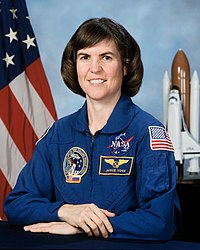Janice Elaine Voss
| Janice Voss | |
|---|---|

|
|
| Country: | United States |
| Organization: | NASA |
| selected on | Jan 17, 1990 ( 13th NASA Group ) |
| Calls: | 5 space flights |
| Start of the first space flight: |
June 21, 1993 |
| Landing of the last space flight: |
February 22, 2000 |
| Time in space: | 49d 3h 49min |
| retired on | February 2012 (deceased) |
| Space flights | |
Janice Elaine Voss (born October 8, 1956 in South Bend , Indiana , † February 6, 2012 in Scottsdale , Arizona ) was an American astronaut .
Life
Voss lived in Rockford , Illinois from 1960 to 1967 , where she attended Guilford Center School. She graduated from high school in 1972 in Wilbraham , Massachusetts . She received a bachelor's degree in engineering from Purdue University in 1975 and a master's degree in electrical engineering from the Massachusetts Institute of Technology (MIT) in 1977 . In 1987 she received a PhD in aerospace engineering , also from MIT.
Voss was a NASA employee at the Lyndon B. Johnson Space Center from 1973 to 1975 . During this time she carried out computer simulations in the engineering and development department. After studying at MIT, she returned to the Johnson Space Center in 1977 and worked as a team coach for a year, specifically for re-entry.
From 1987 Voss worked for Orbital Sciences Corporation . There she was responsible for the TOS upper level (Transfer Orbit Stage). With this upper level, the Advanced Communications Technology Satellite (ACTS) was launched by a space shuttle in September 1993 and the Mars Observer space probe by a Titan rocket in autumn 1992 .
In January 1990, Voss was selected by NASA as an astronaut aspirant. From October 2004 to November 2007 she was Scientific Director for the Kepler Space Telescope at NASA's Ames Research Center . Most recently, she worked as payload manager in the space station department of the astronauts office. She died of breast cancer at the age of 55.
The Cygnus Orb-2 space transporter, launched on July 13, 2014, was named after her.
STS-57
On June 21, 1993 Voss took off on the space shuttle Endeavor on its first flight into space . The main objective of this mission was the recovery of the European Retrievable Carrier Satellite ( EURECA ). In addition, the Spacehab was on board for the first time to carry out various experiments.
STS-63
On February 3, 1995, Voss started as a mission specialist with the space shuttle Discovery for the first flight of a shuttle to the Mir space station . During the mission, on the fourth day of flight, the orbiter approached Mir within eleven meters and held this position for ten minutes. In the further course of the mission, the SPARTAN 204 platform was deployed and recaptured and a four and a half hour space exit was carried out. For the first time, the space shuttle with pilot Eileen Collins was steered by a woman.
STS-83
On April 4, 1997, Voss took off into space on the Columbia space shuttle . The payload was the Microgravity Science Laboratory (MSL-1). Due to a problem with one of the shuttle's fuel cells , the mission had to be shortened and the landing took place after just under four days. NASA decided to repeat the mission three months later with the same crew.
STS-94
On July 1, 1997, Columbia started again on the MSL-1 mission, which was prematurely terminated on the first attempt. This time the experiments in the Microgravity Science Laboratory could be carried out successfully. This included, above all, experiments to research the physical properties of supercooled liquid mixtures and the combustion processes on solid and liquid materials as well as the production of pure protein crystals .
STS-99
On February 11, 2000 Voss flew with the Space Shuttle Endeavor to the so-called Shuttle Radar Topography Mission . Using radar, she mapped 80 percent of the earth's land mass. Two radar systems, one in the shuttle's payload bay and the other mounted on a 60-meter-long mast, scanned the surface of the earth. The result was a digital three-dimensional model of the earth with an accuracy never seen before. In order to enable work around the clock, the six-person crew was divided into two teams that worked twelve hours a day. Voss formed the blue team with pilot Dominic Gorie and mission specialist Mamoru Mōri .
literature
- Dennis Hevesi: Janice Voss, Shuttle Astronaut and Scientist, Dies at 55 . In: The New York Times , February 9, 2012.
See also
Web links
- Short biography of Janice Elaine Voss at spacefacts.de
- NASA biography of Janice Elaine Voss (English; PDF)
- Biography of Janice Elaine Voss in the Encyclopedia Astronautica (English)
- Reuters: Death report
| personal data | |
|---|---|
| SURNAME | Voss, Janice Elaine |
| BRIEF DESCRIPTION | American astronaut |
| DATE OF BIRTH | October 8, 1956 |
| PLACE OF BIRTH | South Bend (Indiana) , Indiana, USA |
| DATE OF DEATH | February 6, 2012 |
| Place of death | Scottsdale , Arizona |

